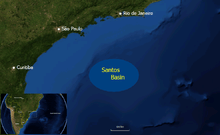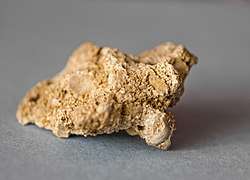Sepetiba Formation
| Sepetiba Formation Stratigraphic range: Pleistocene-Holocene ~2.6–0 Ma | |
|---|---|
| Type | Geological formation |
| Unit of | Itamambuca Group |
| Overlies | Iguape Fm., Marambaia Fm. |
| Thickness | up to 570 m (1,870 ft) |
| Lithology | |
| Primary | Coquina |
| Location | |
| Coordinates | 26°6′S 43°43′W / 26.100°S 43.717°WCoordinates: 26°6′S 43°43′W / 26.100°S 43.717°W |
| Region | Santos Basin, South Atlantic |
| Country |
|
| Type section | |
| Named for | Sepetiba |
 Location of the Santos Basin | |

The Sepetiba Formation (Portuguese: Formacão Sepetiba) is a geological formation of the Santos Basin offshore of the Brazilian states of Rio de Janeiro, São Paulo, Paraná and Santa Catarina. The predominantly coquina formation dates to the Pleistocene period to recent and has a variable but maximum thickness of 570 metres (1,870 ft). The formation is the uppermost unit of the Santos Basin.
Etymology
The formation is named after Sepetiba, a neighbourhood of Rio de Janeiro.
Description
The Sepetiba Formation is the uppermost formation of the Santos Basin stratigraphy. It has a variable thickness, with a maximum of 570 metres (1,870 ft),[1] due to the proximal erosion of the uppermost part. The formation consists of whitish grey fine to coarse grained carbonitic sands. They are feldspar-rich, glauconitic coquinas consisting of bivalve fragments and foraminifera. The depositional environment is thought to be coastal.[2]
See also
References
Bibliography
- Clemente, Pilar. 2013. Petroleum geology of the Campos and Santos basins, Lower Cretaceous Brazilian sector of the South Atlantic margin, 1–33. Danmarks Tekniske Universitet. Accessed 2017-09-04.
- Kiang Chang, Hung; Mario Luis Assine; Fernando Santos Corrêa; Julio Setsuo Tinen; Alexandre Campane Vidal, and Luzia Koike. 2008. Sistemas petrolíferos e modelos de acumulação de hidrocarbonetos na Bacia de Santos. Revista Brasileira de Geociências 38. 29–46. Accessed 2017-09-04.